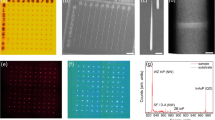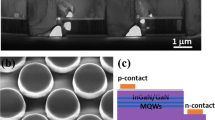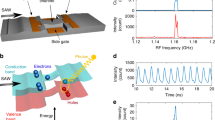Abstract
Scalability and foundry compatibility (as apply to conventional silicon-based integrated computer processors, for example) in developing quantum technologies are major challenges facing current research. Here we introduce a quantum photonic technology that has the potential to enable the large-scale fabrication of semiconductor-based, site-controlled, scalable arrays of electrically driven sources of polarization-entangled photons that may be able to encode quantum information. The design of the sources is based on quantum dots grown in micrometre-sized pyramidal recesses along the crystallographic direction (111)B, which theoretically ensures high symmetry of the quantum dots—a requirement for bright entangled-photon emission. A selective electric injection scheme in these non-planar structures allows a high density of light-emitting diodes to be obtained, with some producing entangled photon pairs that also violate Bell's inequality. Compatibility with semiconductor fabrication technology, good reproducibility and lithographic position control make these devices attractive candidates for integrated photonic circuits for quantum information processing.
This is a preview of subscription content, access via your institution
Access options
Subscribe to this journal
Receive 12 print issues and online access
$209.00 per year
only $17.42 per issue
Buy this article
- Purchase on Springer Link
- Instant access to full article PDF
Prices may be subject to local taxes which are calculated during checkout




Similar content being viewed by others
References
O'Brien, J. L., Furusawa, A. & Vučković, J. Photonic quantum technologies. Nat. Photon. 3, 687–695 (2009).
Gisin, N. & Thew, R. Quantum communication. Nat. Photon 1, 165–171 (2007).
Aspuru-Guzik, A. & Walther, P. Photonic quantum simulators. Nat. Phys. 8, 285–291 (2012).
Ladd, T. D. et al. Quantum computers. Nature 464, 45–53 (2010).
Michler, P. et al. A quantum dot single-photon turnstile device. Science 290, 2282–2285 (2000).
Santori, C., Fattal, D., Vučković, J., Solomon, G. S. & Yamamoto, Y. Indistinguishable photons from a single-photon device. Nature 419, 594–597 (2002).
Akopian, N. et al. Entangled photon pairs from semiconductor quantum dots. Phys. Rev. Lett. 96, 130501 (2006).
Young, R. J. et al. Improved fidelity of triggered entangled photons from single quantum dots. New J. Phys. 8, 29–29 (2006).
Hafenbrak, R. et al. Triggered polarization-entangled photon pairs from a single quantum dot up to 30 K. New J. Phys. 9, 315–315 (2007).
Dousse, A. et al. Ultrabright source of entangled photon pairs. Nature 466, 217–220, (2010).
Juska, G., Dimastrodonato, V., Mereni, L. O., Gocalinska, A. & Pelucchi, E. Towards quantum-dot arrays of entangled photon emitters. Nat. Photon. 7, 527–531 (2013).
Trotta, R., Wildmann, J. S., Zallo, E., Schmidt, O. G. & Rastelli, A. Highly entangled photons from hybrid piezoelectric-semiconductor quantum dot devices. Nano Lett. 14, 3439–3444 (2014).
Kuroda, T. et al. Symmetric quantum dots as efficient sources of highly entangled photons: violation of Bell's inequality without spectral and temporal filtering. Phys. Rev. B 88, 041306(R) (2013).
Versteegh, M. A. M. et al. Observation of strongly entangled photon pairs from a nanowire quantum dot. Nat. Commun. 5, 5298 (2014).
Boretti, A., Rosa, L., Mackie, A. & Castelletto, S. Electrically driven quantum light sources. Adv. Opt. Mater. 3, 1012–1033 (2015).
Salter, C. L. et al. An entangled-light-emitting diode. Nature 465, 594–597 (2010).
Zhang, J. et al. High yield and ultrafast sources of electrically triggered entangled-photon pairs based on strain-tunable quantum dots. Nat. Commun. 6, 10067 (2015).
Juska, G. et al. Conditions for entangled photon emission from (111)B site-controlled pyramidal quantum dots. J. Appl. Phys. 117, 134302 (2015).
Pelucchi, E. et al. Decomposition, diffusion, and growth rate anisotropies in self-limited profiles during metalorganic vapor-phase epitaxy of seeded nanostructures. Phys. Rev. B 83, 205409 (2011).
Dimastrodonato, V., Pelucchi, E. & Vvedensky, D. D. Self-limiting evolution of seeded quantum wires and dots on patterned substrates. Phys. Rev. Lett. 108, 256102 (2012).
Moroni, S. T. et al. Indium segregation during III–V quantum wire and quantum dot formation on patterned substrates. J. Appl. Phys. 117, 164313 (2015).
Zhu, Q. et al. Alloy segregation, quantum confinement, and carrier capture in self-ordered pyramidal quantum wires. Nano Lett. 6, 1036–1041 (2006).
Dimastrodonato, V., Mereni, L. O., Young, R. J. & Pelucchi, E. Growth and structural characterization of pyramidal site-controlled quantum dots with high uniformity and spectral purity. Phys. Status Solidi B 247, 1862–1866 (2010).
Kuhlmann, A. V. et al. Charge noise and spin noise in a semiconductor quantum device. Nat. Phys. 9, 570–575, (2013).
Mereni, L. O., Dimastrodonato, V., Young, R. J. & Pelucchi, E. A site-controlled quantum dot system offering both high uniformity and spectral purity. Appl. Phys. Lett. 94, 223121 (2009).
Benson, O., Santori, C., Pelton, M. & Yamamoto, Y. Regulated and entangled photons from a single quantum dot. Phys. Rev. Lett. 84, 2513–2516 (2000).
Moreau, E. et al. Quantum cascade of photons in semiconductor quantum dots. Phys. Rev. Lett. 87, 183601 (2001).
Schliwa, A., Winkelnkemper, M. & Bimberg, D. Impact of size, shape, and composition on piezoelectric effects and electronic properties of In(Ga)As∕GaAs quantum dots. Phys. Rev. B 76, 205324 (2007).
Seguin, R. et al. Size-dependent fine-structure splitting in self-organized InAs/GaAs quantum dots. Phys. Rev. Lett. 95, 257402 (2005).
Abbarchi, M. et al. Exciton fine structure in strain-free GaAs/Al0.3Ga0.7As quantum dots: extrinsic effects. Phys. Rev. B 78, 125321 (2008).
Langbein, W. et al. Control of fine-structure splitting and biexciton binding in InxGa1-xAs quantum dots by annealing. Phys. Rev. B 69, 161301(R) (2004).
Hudson, A. J. et al. Coherence of an entangled exciton-photon state. Phys. Rev. Lett. 99, 266802 (2007).
Bennett, A. J. et al. Electric-field-induced coherent coupling of the exciton states in a single quantum dot. Nat. Phys. 6, 947–950 (2010).
Plumhof, J. D. et al. Strain-induced anticrossing of bright exciton levels in single self-assembled GaAs/AlxGa1− xAs and InxGa1− xAs/GaAs quantum dots. Phys. Rev. B 83, 121302(R) (2011).
Trotta, R. et al. Universal recovery of the energy-level degeneracy of bright excitons in InGaAs quantum dots without a structure symmetry. Phys. Rev. Lett. 109, 147401 (2012).
Karlsson, K. F. et al. Fine structure of exciton complexes in high-symmetry quantum dots: effects of symmetry breaking and symmetry elevation. Phys. Rev. B 81, 161307(R) (2010).
Young, R. J. et al. Bell-inequality violation with a triggered photon-pair source. Phys. Rev. Lett. 102, 030406 (2009).
Ekert, A. K. Quantum cryptography based on Bell's theorem. Phys. Rev. Lett. 67, 661–663, (1991).
Zhang, J. et al. Electric-field-induced energy tuning of on-demand entangled-photon emission from self-assembled quantum dots. Preprint at: https://arxiv.org/abs/1604.04501 (2016).
Trotta, R. et al. Wavelength-tunable sources of entangled photons interfaced with atomic vapours. Nat. Commun. 7, 10375 (2016).
Stevenson, R. M. et al. Indistinguishable entangled photons generated by a light-emitting diode. Phys. Rev. Lett. 108, 040503 (2012).
Ma, Y., Kremer, P. E. & Gerardot, B. D. Efficient photon extraction from a quantum dot in a broad-band planar cavity antenna. J. Appl. Phys. 115, 023106 (2014).
Gschrey, M. et al. Highly indistinguishable photons from deterministic quantum-dot microlenses utilizing three-dimensional in situ electron-beam lithography. Nat. Commun. 6, 7662 (2015).
Lindenmann, N. et al. Photonic wire bonding: a novel concept for chip-scale interconnects. Opt. Express 20, 17667–17677 (2012).
James, D. F. V., Kwiat, P. G., Munro, W. J. & White, A. G. Measurement of qubits. Phys. Rev. A 64, 052312 (2001).
Shields, A. J., Stevenson, R. M. & Young, R. J. in Single Semiconductor Quantum Dots (ed. Michler, P. ) 227–265 (Springer, 2009).
Clauser, J. F., Horne, M. A., Shimony, A. & Holt, R. A. Proposed experiment to test local hidden-variable theories. Phys. Rev. Lett. 23, 880–884 (1969).
Acknowledgements
This research was enabled by the Irish Higher Education Authority Programme for Research in Third Level Institutions (2007–2011) via the INSPIRE (Integrated NanoScience Platform for Ireland) programme, and by Science Foundation Ireland under grants 10/IN.1/I3000 and 07/SRC/I1173. The authors are grateful to K. Thomas for the MOVPE system support.
Author information
Authors and Affiliations
Contributions
T.H.C. fabricated the devices. G.J. and S.T.M. carried out optical characterization, data processing and analysis. A.P. undertook the theoretical calculations. A.G. grew the samples and operated the MOVPE system. E.P. conceived the study and participated in its design and coordination. All authors commented on the final manuscript.
Corresponding author
Ethics declarations
Competing interests
The authors declare no competing financial interests.
Supplementary information
Supplementary information
Supplementary information (PDF 645 kb)
Rights and permissions
About this article
Cite this article
Chung, T., Juska, G., Moroni, S. et al. Selective carrier injection into patterned arrays of pyramidal quantum dots for entangled photon light-emitting diodes. Nature Photon 10, 782–787 (2016). https://doi.org/10.1038/nphoton.2016.203
Received:
Accepted:
Published:
Issue Date:
DOI: https://doi.org/10.1038/nphoton.2016.203
This article is cited by
-
Recent progress in quantum photonic chips for quantum communication and internet
Light: Science & Applications (2023)
-
An intuitive protocol for polarization-entanglement restoral of quantum dot photon sources with non-vanishing fine-structure splitting
Scientific Reports (2022)
-
Towards 3D characterisation of site-controlled InGaAs pyramidal QDs at the nanoscale
Journal of Materials Science (2022)
-
The potential and global outlook of integrated photonics for quantum technologies
Nature Reviews Physics (2021)
-
Distributing entanglement with separable states: assessment of encoding and decoding imperfections
Quantum Information Processing (2021)



